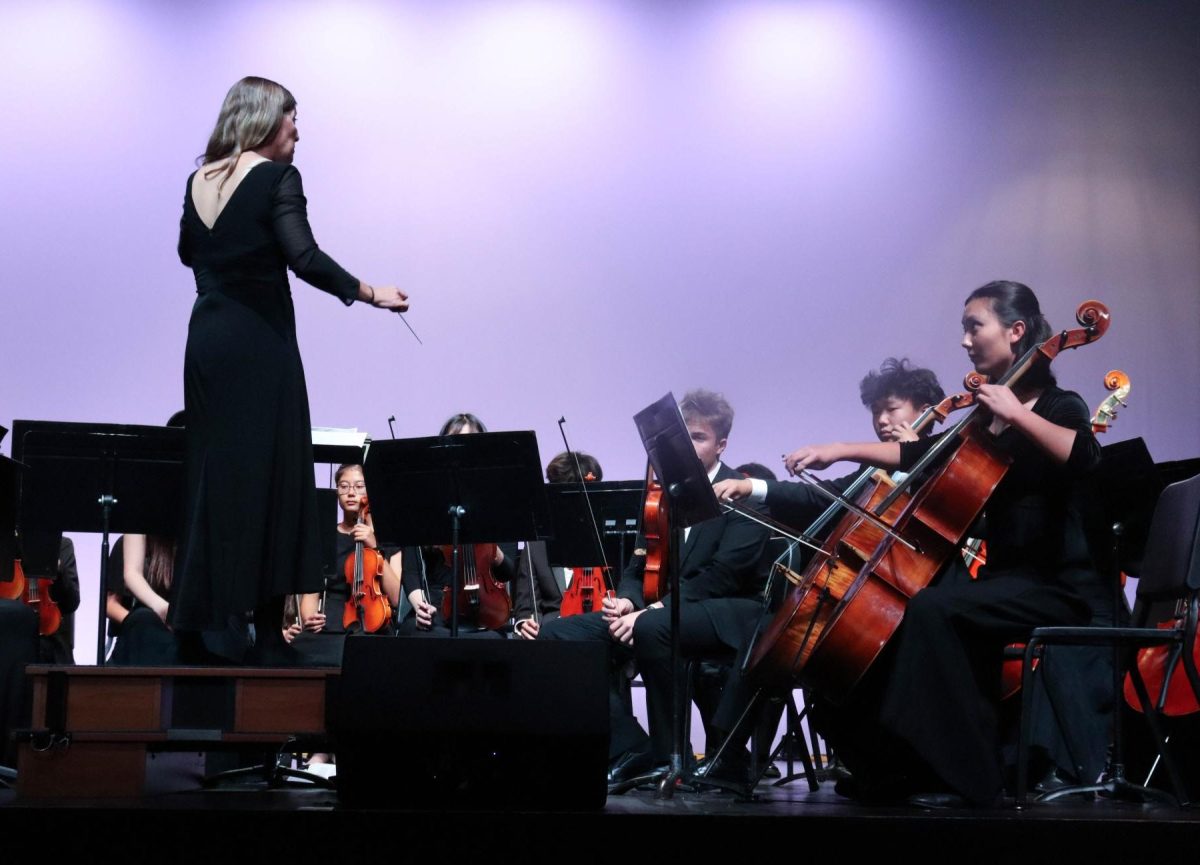
Claire Zhou
Conductor Amy Gelb (left) begins "Fantasy on Amazing Grace" by turning to the first chair Vera Muller (10) (right). The piece swept through Baroque, Classical, Romantic and early 20th century period styles.
Under soft stage lights and a backdrop the shade of delicate lavender, the school music department stitched note after golden note into the PAC at its annual Fall Concert last Thursday, featuring performances by Wind Ensemble, Orchestra, Jazz Band and — for the first time — Instrumental Music.
Also new this year, the music department hosted silent auctions for gift baskets sponsored by local businesses, such as PRETTY PLEASE!, Jimbos and Del Mar Golf Shop. Like previous concerts, they sold baked goods: brownies, cookies and passion fruit jam.
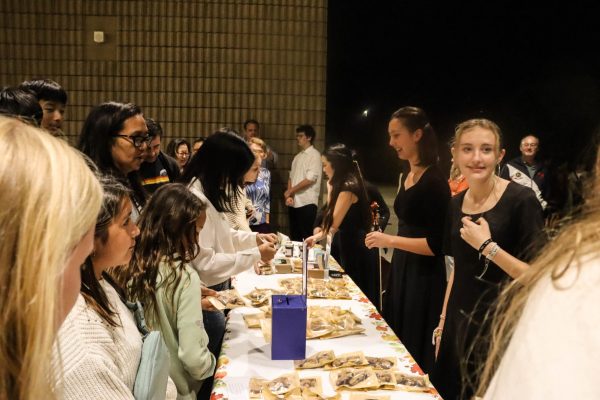
“I have a group of students [music council] who helped me with the spirit raising and fundraising,” Amy Gelb, Music Director, Orchestra, Band, Jazz Band and Instrumental Music and MIDI Composition/Recording Arts teacher, said. “They made the big sign we put on the door… I wrote a letter, and they delivered it to the Highlands, asking for donations. Then once we brought in the donations, … [Parent Liaisons] put together the baskets. We ended up making $560 just from the auction. [For] the bake sale, the kids from the music council made everything themselves.”
The night opened with guitarist Steven Xu (11) from Instrumental Music, who played a solo piece, “Carmen Habanera” by Marcin Patrzalek. Gelb taught the class at San Dieguito High School for the past two years, then brought it to this school along with MIDI Composition.
The first time Gelb heard Xu play the guitar, she decided that “he has to perform. Everyone has to hear him play.”
“To be honest, I was nervous,” Xu said. “When the audience was getting into the theater, I thought, ‘Oh, there were so many people and students getting prepared on stage.’”
Xu opened the night with a sound sharp and metallic as he dragged his fingernail along his guitar’s baseline string before dropping into Habanera’s climbing and falling rhythm. Bass thrummed as the melody rose and fell, his palms and knuckles striking the soundboard and upper bout while strumming chords in D minor and major.
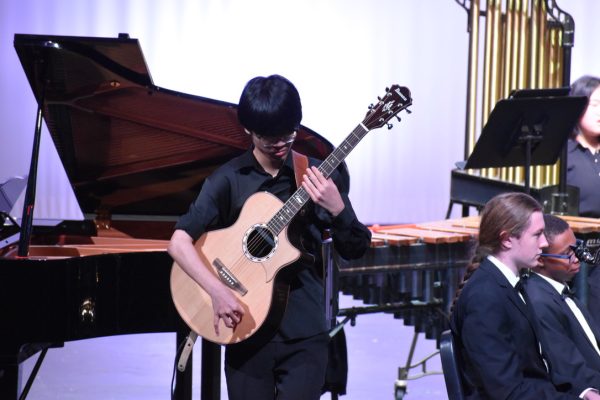
“Believe it or not, I really hated playing guitar when I was a child,” Xu said. “But from grade six, I started to fall in love with it … I chose the song [for] several reasons. First, the time to prepare is not so long, so I chose a song that I used to play a little bit … [and] I heard Ms. Gelb say the concert was going to [include] Orchestra and other bands, so I think they’re playing classical music. Carmen was a really classic, famous and popular opera. Also, I think [the piece] is quite cool.”
Auditorium lights opened again and Gelb returned to the stage. For a second, the stage was an outline of concert black and silence. Gelb raised her baton and the Wind Ensemble shimmered as students lifted their instruments, stage lights glinting on silver clarinets and flutes. Music bloomed as “Joy of Love and Life” began.
“During the solo, at the beginning you kind of feel a little bit nervous right before you’re going to play it, but as you’re playing it, you really don’t feel anything, or at least I don’t,” first chair clarinet “Joy of Love and Life” soloist Michael Zheng (10) said. “And even if you mess up, you still have to carry on with the solo no matter what happens … I kind of just let my muscle memory just take it away.”
The first three pieces referenced a bright and cheerful tone, leaning toward a folk-like soundscape dotted by twinkling wind chimes. “Everlight,” which Zheng described as a “happier piece,” opened with light notes from percussion and flutes fluttering ever so slightly, like sunrise beginning to peek over a meadow. Jake Tang’s (9) saxophone solo emerged as an isolated melody, then at once, all sections of the ensemble bloomed with each crash cymbal strike, echoing the same melody.
“I’m really proud of ‘Festival De La Homiga Fire Ant,’” Gelb said. “That is a very complicated piece. It’s a grade four-point-five … That’s a huge jump for a lot of the freshmen who are playing grade two to two and a half in middle school. When I first passed it out to them, they just didn’t even know what to do with it, because it has a lot of mixed-meter. A lot of them told me: ‘I’ve never even played in six-eight’ … and now they’re playing seven-eight and shifting the beat at five-eight, three-eight and all over the place.”
At the end of the piece, her hands pulled into a cut-off, and the stage was suspended in silence. Slowly, Gelb let her arms fall, and the ensemble lowered their instruments. The audience exhaled in applause as Gelb stepped down from her conductor’s podium, tucked a strand of hair behind her ear and, from the side of the stage, raised her arms for the audience to clap as students rose.
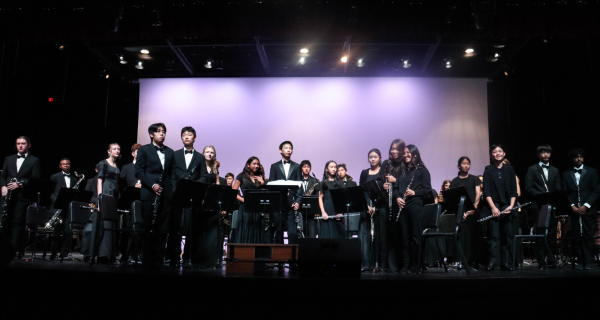
Theater lights flicker on in between sets, and Wind Ensemble cleared for Orchestra to file in. They sat still for a moment before Gelb returned to the podium and opened her arms. She took a deep breath, and a silhouette strung taut between wood and string spilled into “Danse Negré.”
“My favorite piece might be rather unconventional,” first chair cello Vera Muller (10) said. “It was a piece called ‘Danse Negré’ by Samuel Coleridge Taylor, who is also one of my favorite composers. That piece has an interesting rhythm, and it’s quite happy … It’s classical, but it also has some African stylistic inspiration, so it’s rather unconventional. It was written in the 1800s, but it was one of the first pieces to do this kind of cross-cultural incorporation.”
Following “Danse Negré,” “Fantasia on Amazing Grace” began in the cello section, before the rest of the orchestra joined in retelling the original hymn, sweeping through Baroque, Classical, Romantic and early 20th century period styles.
Most modern of the setlist, though, was the contemporary piece published in February: “Black Orchid.” The piece first breathed like night-blooming jasmine, a somber and subtle tension lightened by a harp, then transitioned into an agitated hum. Its harmony rose and fell to twinkling glockenspiel as cello and viola swelled. At last, string textures faded while harp unfolded the melody in a glissando as though waking from a dream.
“We played ‘Melodie,’ which is originally a piano piece by Tchaikovsky,” Muller said. “It was arranged for Orchestra and then a violin solo. Anthony Kim (12) did that. We also played the ‘Egmont Overture,’ which was our finale, and it’s about the life of a count named Egmont.”
Kim had just landed from a red-eye flight the day of the concert.
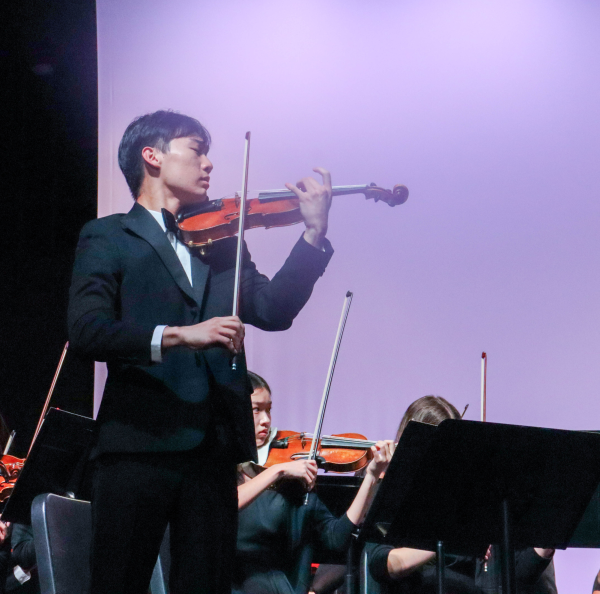
“It’s a very expressive piece, lots of vibrato, rubato — which means pushing and pulling of the tempo,” Kim said. “There’s a few sections that come out compared to when I’m playing the solo. So I might have a trill … and for that section, the first violins and the cellos should come out … There’s sections of beauty. There’s also sections of uncertainty.”
Theater lights switched on as some chairs were swapped out for a drum set and two acoustic shell panels. The piano was moved closer to center stage. Saxophones took a seat at the front, and Gelb joined them — partly because they are short a saxophone, but also because of her love for the instrument.
Jazz opened with one of the crowd favorites: “Absoludicrous,” a signature Gordon Goodwin high-octane, 120 BPM chart that started with an electric piano riff. The piece featured solos by violinist Jenny Ryu (12) and pianist Arno Janoyan (11).
“For ‘Absoludicrous,’ I can’t lie, I was a little nervous because it’s a tough song,” Janoyan said. “But this is my sixth Torrey concert, so I wasn’t that nervous.”
His fingers did not strike the piano keys so much as they tangoed. From note to note, the auditorium tilted toward the keys — funk-style jazz was alive and vibrant as Janoyan leaned into each tremolo. His feet, too, tapped to Goodwin’s upbeat starts and stops. During Janoyan’s solo, the room seemed to forget gravity; only the world built by the electric guitar, drums and vibraphone remained.
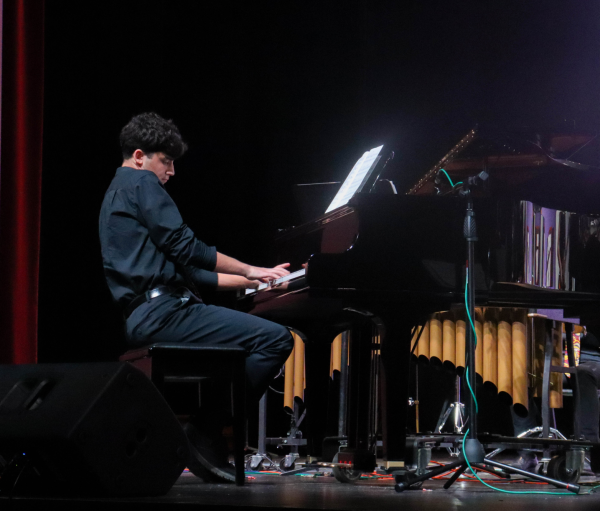
“[The solo] is fully improvised,” Janoyan said. “The way I solo, I learn a scale or a motif or a certain aspect, or maybe I’ll transcribe something for the solo that I like by another artist, and put my own kind of spin on it. … So I’m thinking, ‘how can I naturally progress my solo to get it more energetic and have kind of a build up?’ And also, I’m trying really hard not to mess up.”
In “I’ve Grown Accustomed to His Face,” Lindy Crosby’s (12) vocals were of warm, smooth timbre as she weaved from singing to scatting, brass instruments braiding through her voice. Gioia Nowers (10) delivered softer, intimate, yet clear vocals in “Nearness of You,” swaying ever so slightly while singing, as if in a slow dance.
At the end of the night, the concert finished with a Jazz Band favorite: “Sir Duke.”
“I know they probably liked ‘Sir Duke’ the most, that and ‘Absoludicrous,’ because they’re more exciting,” Gelb said. “But Sir Duke was very challenging. That’s a Stevie Wonder tune… but this arrangement went into double time … and had this big band solo that’s, like, 20 times harder than the original.”
Even from the back of the theater, the audience saw saxophonists waver their heads to the melody, the electric guitarist’s heel taps keeping time.
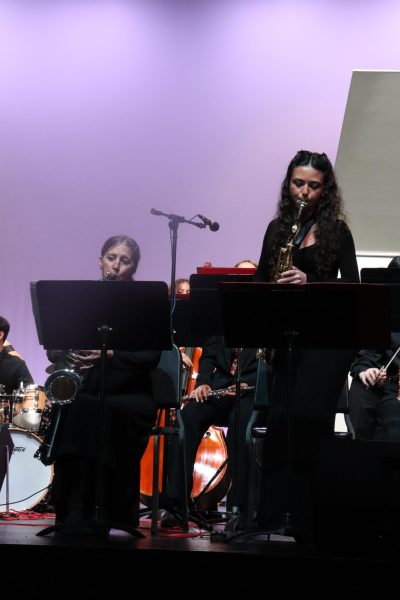
As the audience listened, they heard more than just practice since the first day of school, when the concert’s sheet music was passed out. Every note was carved by calluses on fingertips, the hold of an instrument like second nature and tempos engraved into muscle memory. For Janoyan, it was a decade of classical training. For Gelb, it was a lifelong dedication to music and 26 years of teaching. Now, it is “kind of creepy” that she is not nervous for concerts.
“I was always drawn to [the saxophone] when I was young,” Gelb said. “I love how it resonates, the sound. I started piano when I was like five, then when it was time to join Band in fourth grade, I wanted to play saxophone, but actually, the music director said that it was full because they had caps on certain sections, and I was crushed.”
So Gelb played the clarinet, then moved to the bass clarinet to sit by the saxophone.
“I started teaching myself saxophone,” Gelb said. “When I got to middle school, they asked me what I played. I said, ‘saxophone,’ and then I got first chair.”
As music department director, teacher of five class periods at this school, conductor, saxophonist and mother of four, Gelb’s charming love for music and teaching radiates past the music room’s wall quotes — “When words stop, music starts” or “Without music, life would B-flat” — and ripples through the notes that flows from her fingertips into the PAC audience.
Looking forward, the music department plans to host a See’s Candies fundraiser on Nov. 1 and annual Winter Concert on Dec. 10.
“Every concert should be a little bit better, a little bit better, improving technique, improving musicality, listening to each other, the level of musicianship,” Gelb said. “And then also, just building a sense of community.”